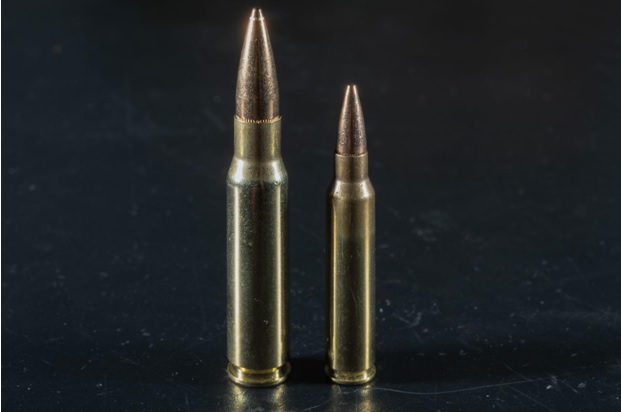A (Very) Short History of 7.62x51mm NATO
Apr 24th 2024
Need a new M14 barrel? Do you hunt with .308 Winchester?
Then you should be interested in the history of 7.62x51mm. It is the catalyst for, or enabler of, both those conditions.
It also gave rise to one of the most popular cartridges ever (the aforementioned, which actually technically preceded it, in a manner of looking at it) which is widely used throughout the world, for hunting both medium and large game.
Let’s take a closer look.
The Origins of 7.62x51mm NATO
Enter the .30-06 Springfield, the immediate official predecessor to the 7.62x51mm NATO.
It’s large. It’s powerful. It’s heavy. It produces a lot of recoil.
You get the picture, but it’s only half positive. The power of that cartridge is bad news for the target on the receiving end, but guess what - that doesn’t make it good news for the guy holding the rifle.
Platforms built around .30-06 were also heavy, and the ammo itself was tiring to carry. Not to mention the fact it was difficult to adapt to automatic platforms and machine guns.
The United States knew there was a better way. Or at least, there had to be. Other countries were using cartridges like 7.62x39mm Soviet and 7.92x33mm Kurz to great effect.
Admittedly, the military was looking into alternatives before those other cartridges were developed - but they were launched earlier than the 7.62x51mm NATO. The Soviets and Germans, respectively, were using them when our boys were still carrying M1 Garand rifles chambered in the aught-six.
After the Second World War: that’s when work on the 7.62x51mm NATO began in earnest.
The Army actually began work to improve the Garand before it started looking into a new cartridge, though. One of the common complaints about the Garand was that capacity was limited.
This is, as you can imagine, partially a product of the size of the cartridge it fired. So, the Army started experimenting with a variant of the M1 Garand that accepted a detachable box mag.
That was a step in the right direction, but didn’t go the distance, so they started playing around with the idea of a new cartridge: officially designated by Frankford Arsenal, which developed it, as the T65, or 7.62x47mm.
The T65 cartridge had to go through two more variations, the T65E1 and T65E2 before it would officially occupy the dimensions of our 7.62x51mm NATO cartridge.
That would be the T65E3, or 7.62x51mm, which had a 20° shoulder and was loaded with a lead-cored bullet with a steel jacket.
The final variation in testing performed by Frankford Arsenal was the T65E5, which was basically the same as the T65E3, except that the bullet was boat tailed. This was the version adopted by the military in 1954 as 7.62x51mm NATO.
(Interesting fact, Winchester took the design and ran with it, releasing the .308 Winchester in 1952, two years before the military officially accepted it.)
The first official battle rifle adopted for use with the 7.62 NATO was the M14. The good news: the new cartridge was lighter than .30-06, and more compact, meaning more could be carried, and a higher capacity could be comfortably contained in a magazine - such as those used by the M14, which accepted both 10 and 20 round detachable box mags.
It also produced less recoil than the .30-06 and produced comparable stopping power, even at fairly extended ranges - though it was short of its predecessor.
But it wasn’t all good news. It quickly became apparent that due to the recoil of the cartridge (despite the fact that it was less than the aught-six), it was nearly impossible to control shoulder-mounted arms when firing on full-auto.
This, of course, is only a shortcoming of the cartridge, to say nothing of the rifle, which was probably the most hated battle rifle of all time. But that’s a topic for another day.
So why is the 7.62x51mm NATO basically a fossil?
Why It Didn’t Last Long

What it comes down to is that the 7.62x51mm NATO is just bigger than it needs to be. It’s smaller and lighter than .30-06, but that isn’t saying much. It’s still big, heavy, and too hard to control in full-auto.
The 5.56 NATO served up its death warrant, when testing in the early 60s showed that soldiers armed with 5.56-chambered rifles could easily outgun combatants armed with heavier M14 rifles.
That was that. The 5.56 is lighter, easier to carry, and far easier to control when firing on full-auto, not to mention the fact that it is a flat-shooter, even at extended ranges, and produces excellent ballistic performance - regardless of the fact that it is technically inferior to the 7.62 in terms of power.
It was good enough, and better than 7.62x51mm NATO, and that’s the reason all our rifles are (more or less) still chambered in 5.56x45mm NATO today.
Where It Lives on
Despite the fact that 5.56 has been king of the hill for more than 60 years, the 7.62x51mm lives on in the .308 Winchester, which technically preceded it anyway.
Competition shooters and hunters still love the .308, which produces excellent stopping power and can take any game in North America. And, when you’re shooting a bolt-action, who cares about control under full-auto?
Just remember this: the paradigm of 5.56 vs .223 is flipped with 7.62 and .308: you cannot fire .308 in a 7.62x51mm-chambered rifle, or you run the risk of case rupture or worse, so don’t try it.
Here Because You Need a New M14 Barrel?
Not that M14 barrels are prone to shoot-out, but if you need to replace one, we’re your source. Check out our M14 barrels and other M14 parts here and get in touch with us if you need other parts. We’re more than happy to help.

